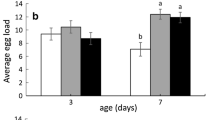Abstract
ImmatureLymantria dispar L. were collected from 6 geographically distinct populations over 2 years to determine correlations between parasitoid and disease incidences. Incidence of the nuclear polyhedrosis virus disease (NPV) was found to be positively correlated with incidences of the parasitoidsApanteles melanoscelus (Ratzeburg) andParasetigena silvestris (Robineau-Desvoidy).
Résumé
Les stades juvéniles deLymantria dispar L. provenant de 6 populations géographiquement distinctes ont été recueillis pendant une période de 2 ans dans le but de déterminer des corrélations entre l'incidence des parasitoides et l'incidence de maladies. On a trouvé une corrélation positive entre l'incidence de la polyhedrose nucléaire (NPV) et l'incidence des deux parasitoidesApanteles melanoscelus (Ratzeburg) etParasetigena silvestris (Robineau-Desvoidy).
Similar content being viewed by others
References
Bird, F.T. — 1961. Transmission of some insect viruses with particular reference to ovarial transmission and its importance in the development of epizootic. —J. Insect. Pathol., 3, 352–380.
Blunck, H. — 1952. Ueber die beiPieris brassicae L., ihren Parasiten und Hyperparasiten schmarotzenden Mikrosporidien. —Trans. 9thInt. Congr. Entomol., 1, 432–438.
— — 1954. Microsporidien beiPieris brassicae L., ihren Parasiten und Hyperparasiten. —Z. Angew. Entomol., 36, 316–333.
Campbell, R.W. — 1971. Developing a pest population management system. —Proc. Tall Timbers Conf., 9–20.
Campbell, R.W. &Podgwaite, J.D. — 1971. The disease complex of the gypsy moth I. major components. —J. Invertebr. Pathol., 18, 101–107.
Readon, R.C., Statler, M.W. &McLane, W.H. — 1973. Rearing techniques and biology of five gypsy moth parasites. —Environ. Entomol., 2, 124–127.
Steinhaus, E.A. — 1963. Insect Pathology. An Advanced Treatise. —Academic Press, New York, 689 pp.
Tanada, Y. — 1955. Field observations on a microsporidian parasite ofPieris rapae L. andApanteles glomeratus L. —Proc. Hawaiian Entomol. Soc., 15, 609–616.
Voukassovitch, P. — 1925. Contribution à l'étude d'un champignon entomophyteSpicaria farinosa (Fries) var.verticilloides Fron. —Ann. Inst. Nat. Rech. Agron., C., 2, 73–106.
White, R.T. — 1943. Effect of milky disease onTiphia parasites of Japanese beetle larvae. —J. N. Y. Entomol. Soc., 51, 213–218.
Author information
Authors and Affiliations
Additional information
The work herein reported was funded in whole or in part by a U. S. Department of Agriculture sponsored program entitled “The Expanded Gypsy Moth Research and Applications Program.”»
Rights and permissions
About this article
Cite this article
Reardon, R.C., Podgwaite, J.D. Disease-parasitoid relationships in natural populations ofLymantria dispar [Lep.: Lymantriidae] in the Northeastern United States. Entomophaga 21, 333–341 (1976). https://doi.org/10.1007/BF02371630
Issue Date:
DOI: https://doi.org/10.1007/BF02371630




